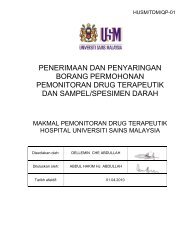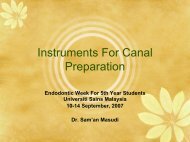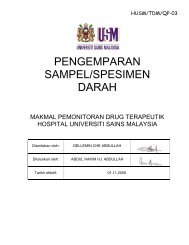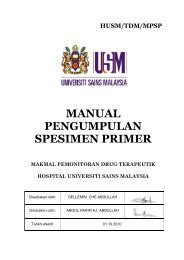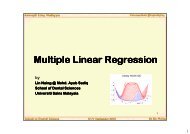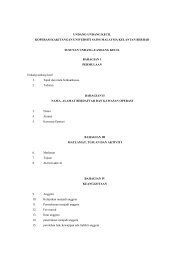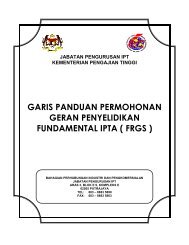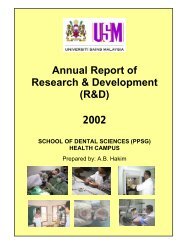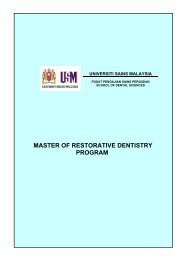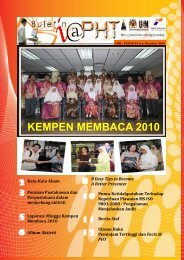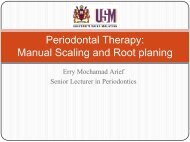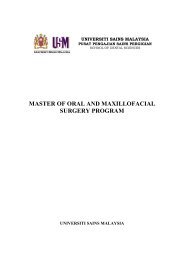Vol 11-R2- Eyelid
Vol 11-R2- Eyelid
Vol 11-R2- Eyelid
Create successful ePaper yourself
Turn your PDF publications into a flip-book with our unique Google optimized e-Paper software.
SRPS • <strong>Vol</strong>ume <strong>11</strong> • Issue <strong>R2</strong> • 2010<br />
with additional lid laxity, a defect consisting of<br />
up to 40% of the lower eyelid margin can also be<br />
closed directly. As revealed earlier; a pentagonal<br />
excision closure with the buried vertical mattress<br />
technique 15,40 is preferred over the classically taught<br />
three-suture technique.<br />
Lateral Canthotomy and Inferior Cantholysis<br />
If direct closure causes excessive tension on the<br />
wound edges, a lateral canthotomy and inferior<br />
cantholysis can notably mobilize the lateral portion<br />
of the defect. As described earlier, a number 15<br />
Bard-Parker blade is used to make an approximately<br />
5-mm horizontal incision in the skin at the lateral<br />
canthus. 75,88,89 The incision is continued down to the<br />
orbital rim. The inferior ramus of the lateral canthal<br />
tendon should then be identified with scissor tips.<br />
Using Westcott scissors pointed toward the lateral<br />
orbital rim, the inferior arm of the lateral canthal<br />
tendon is cut from the orbital rim (Fig. 12). The<br />
lower lid should easily pull away from the lateral<br />
canthus. The lateral margin of the wound can then<br />
be mobilized nasally to close the lid margin defect. 75<br />
Figure 12. With the scissors pointed inferoposteriorly<br />
toward the lateral orbital rim, the inferior arm of the lateral<br />
canthal tendon is cut.<br />
24<br />
Tenzel Rotational Flap<br />
Lower eyelid defects involving 40% to 60% of the<br />
lid margin can be closed with a lateral, semicircular<br />
miniflap rotated into the lid defect. 75,103 Similar<br />
to the technique used in creating a pentagonal<br />
configuration for direct closure of a lid defect, the<br />
tissue inferior to the tarsal defect is excised in a<br />
triangular shape. A superior arching line is drawn<br />
on the skin beginning from the lateral canthus<br />
extending temporally to the lateral extension of<br />
the brow line (Fig. 13). The diameter of the flap<br />
drawn is approximately 20 mm. 75 The outline is<br />
incised with a blade, and a lateral canthotomy<br />
incision is made below the flap with subsequent<br />
dissection down to the lateral orbital rim. An<br />
inferior cantholysis is then performed. The flap is<br />
undermined and rotated nasally.<br />
Lateral lid support must be re-established<br />
to prevent lateral drooping of the eyelid. This is<br />
accomplished by suturing the dermis of the flap<br />
tissue to the inner periosteum of the superior inner<br />
aspect of the lateral orbital rim. 75<br />
The Tenzel flap can also be supplemented with<br />
periosteum or ear cartilage for slightly larger defects<br />
to create a support for the lateral eyelid. A periosteal<br />
flap is created by elevating a strip from the lateral<br />
orbital rim and keeping it hinged off the orbital<br />
rim. The flap is stretched across and attached to the<br />
inside of the advanced Tenzel flap. Alternatively, an<br />
ear cartilage graft can be used to support the lateral<br />
portion deficient of tarsus. 75,103<br />
Hughes Flap<br />
Larger defects that involve more than 50%<br />
(depending on lid laxity) of the lower lid margin<br />
are ideally closed with a Hughes flap. 69 In 1937,<br />
Hughes 104 presented a method for lower eyelid<br />
reconstruction that makes use of the upper eyelid<br />
as the donor site. See also Hughes 105 (1945) and<br />
Rohrich and Zbar 106 (1999). A tarsoconjunctival<br />
flap was created from the ipsilateral upper eyelid,<br />
and it was advanced inferiorly into the lower eyelid<br />
defect to replace the absent posterior lamella.<br />
Hughes undermined cheek skin to elevate it,<br />
replacing absent lower lid skin without tension. The



